

3/2006
Hydrogen joins hot water as a renewable energy source for the mid-Atlantic island

by Russell Boniface
Associate Editor
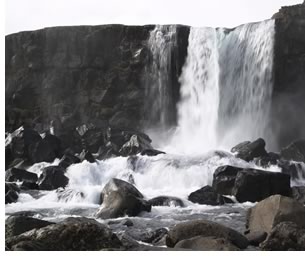 When you think of Iceland, you might think of glaciers. But would you
think of volcanoes?
When you think of Iceland, you might think of glaciers. But would you
think of volcanoes?
This island nation is a mere 40,000 square miles between the Greenland Sea and the North Atlantic Ocean, northwest of the United Kingdom. Despite being called “Iceland,” the nation is, ironically, quite hot. It sits on a geological hot spot, resulting in volcanoes, lava, and geysers that melt ice to form numerous rivers, lakes, and waterfalls. With so much water on hand, Icelanders see a unique chance to finally dispatch their oil dependency, or, as they humorously say, kick their oil habit.
Fire and water
Large volcanoes strewn around the island generate boiling underground
lake water at a rapid clip, making available geothermally heated water,
which is piped from underground, stored in tanks, then piped into cities.
About two-thirds of the entire island nation runs on this clean geothermal
heat. Making renewable energy is an already familiar concept to Icelanders.
In addition, water is harnessed for hydropower, so most households
enjoy cheap electricity for a low price.
Now, Iceland’s population of 300,000 want to take that one step further by disposing of oil altogether by turning its water into hydrogen fuel for cars, buses, trucks, and fishing vessels. “They have geothermal heat, water, wind, and steam in abundance and feel they have the ability to convert it to hydrogen and a commitment to do that in a major way,” says Professor Stephen R. Lee, AIA, Center for Building Performance and Diagnostics School of Architecture, at Carnegie Mellon in Pittsburgh. “The only source of external energy they have is the gas and diesel fuel, so if they can crack the nut of getting a hydrogen-based economy, they won’t need to import anything at all to run their entire country, and that is what their goal is at this point in time.”
History of independence
Key to understanding Icelanders’ desire to become oil-free is the
high importance its culture places on independence and self-reliance.
Brief history: Settled by Scandinavian, Scottish, and Irish immigrants
during the late 9th and 10th centuries, Iceland was independent for more
than 300 years before being taken over by Norway and Denmark, much to
the disdain of the locals. Limited home rule from Denmark was granted
in 1874. Despite a volcano blast the next year, the Icelanders persevered
and rebuilt their land and economy, thus attaining complete independence
in 1944. Kicking their oil dependency seems natural to Icelanders: A
recent survey has shown that 93 percent of the Icelandic people are very
positive about the idea of replacing traditional fossil fuels with hydrogen.
 Hydropower
currently provides 18 percent of Iceland’s primary
energy supply and 84 percent of its electricity generation. Approximately
50 percent of Iceland’s total primary energy is supplied by geothermal
power, with about 86 percent of households being supplied. Even streets
and sidewalks are heated to melt snow and ice (and keep their feet warm)—there
are no snow shovels in Iceland. But perhaps the most evident example–and
most popular—is the geothermal spa. There are 126 geothermal pools
in Iceland for its 300,000 residents. (To put that in perspective, New
York City has 68 public swimming pools for its 8 million residents.)
Hydropower
currently provides 18 percent of Iceland’s primary
energy supply and 84 percent of its electricity generation. Approximately
50 percent of Iceland’s total primary energy is supplied by geothermal
power, with about 86 percent of households being supplied. Even streets
and sidewalks are heated to melt snow and ice (and keep their feet warm)—there
are no snow shovels in Iceland. But perhaps the most evident example–and
most popular—is the geothermal spa. There are 126 geothermal pools
in Iceland for its 300,000 residents. (To put that in perspective, New
York City has 68 public swimming pools for its 8 million residents.)
Although hydrogen fuel is expensive to produce, it gets up to three times the mileage of gas, making the overall cost of hydrogen about the same as gas. Iceland’s current oil imports are about 15,470 barrels per day. That translates into $150 million a year importing 850,000 tons of oil to meet only 35 percent of its energy needs. But a large benefit to hydrogen fuel is there are no carbon emissions—only trails of water vapor. Despite running most of the country on geothermal and hydropower, Iceland does have an existing pollution problem due to its transport sector; fishing fleet, a major economic resource; and an expanding metal smelting industry, making Iceland one of the world's top per capita emitters of greenhouse gas. Widespread use of hydrogen fuel cells could possibly cut Iceland's greenhouse gas emissions by a third, according to estimates.
 Breaking the ice
Breaking the ice
Iceland has been at the forefront of developing hydrogen fuel technology
for decades. Actually, the science of converting water to hydrogen
fuel isn’t too difficult. One molecule of water is composed of
two hydrogen atoms and one oxygen atom. Iceland’s plan is for
electrodes to split the water’s hydrogen and oxygen molecules.
The hydrogen electrons in the water molecule then pass through an electrical
conductor, which, in turn, powers an engine. The only issue is constructing
pipes from the proper metal to maintain the gas and prevent a breach.
Icelandic New Energy (INE) was formed by investors DaimlerChrysler, Norsk Hydro, and Shell Hydrogen in 1999 to research and test the hydrogen fuel cell technology. INE general manager and co-founder Jon Bjorn Skulason believes the hydrogen vision can be adapted to reality. “At the end of the last century there was already a high optimism for hydrogen,” he points out. “Technological development had moved on—but not yet commercial realization.” The first task of INE was to create the four-year ECTOS project, which centered on three Daimler-Chrysler hydrogen-powered electric buses refueling at a Shell-branded hydrogen refueling station using Norsk Hydro electrolysis technology. ECTOS stands for “Ecological City Transport System,” and the project started in 2002 and aimed to put hydrogen driven buses into a normal bus route in Reykjavik.
The first two years were spent on environmental research, development of infrastructure, establishing maintenance routines, training personnel, and preparing for the arrival of the buses. Over the following two years, the hydrogen buses have been driving normal routes and refueling at the Shell station. INE conducted socio-economic research, a comparison with other energy sources, and a cost-benefit analysis. In Reykjavik, the buses won rave reviews. Hydrogen buses of the same type are now being used in several cities in Europe, Australia, China, and Germany.
“One thing is for sure—this is an exciting time for the hydrogen industry,” says Gabriel de Scheemaker, general manager of Shell Hydrogen. “Hydrogen is for courageous managers—both in government and in business. Visionary leaders are passionate about making it happen. We are realistic. We know it will be a long journey, with many twists and turns. The future could be just over two decades away, but only if we start today; otherwise, 10 years from now it will still be two decades away.”
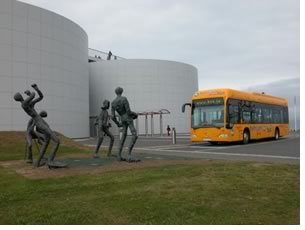 Despite one ruptured pipe at the Shell station, leading to a minor redesign,
the INE viewed the bus project a success, still rolling into 2006. States
Skulason: “Iceland has an abundant renewable energy source, a small
society, and a high level of energy know-how. Iceland has a similar transportation
system and standards as most other developed countries, and therefore
the results can easily be adapted elsewhere.”
Despite one ruptured pipe at the Shell station, leading to a minor redesign,
the INE viewed the bus project a success, still rolling into 2006. States
Skulason: “Iceland has an abundant renewable energy source, a small
society, and a high level of energy know-how. Iceland has a similar transportation
system and standards as most other developed countries, and therefore
the results can easily be adapted elsewhere.”
Buses were used in the ECTOS project because finding a cost-effective method of storing hydrogen in a car is a challenge. While hydrogen contains more energy per weight than any other energy carrier, it also contains much less energy by volume. This makes it difficult, at the moment, to store a large amount of hydrogen in a small space, like in a gas tank of a car. But companies like General Motors have developed a cost-efficient lightweight hydrogen fuel gas tank and has made it available in some cars. Iceland is anticipating a growth in this technology, as well as the possibilities of liquid hydrogen car tanks, and is already planning to gradually switch the nation's 180,000 vehicles to hydrogen power—first buses, then cars, then its 2,500 fishing vessels.
Is it safe?
But will a hydrogen vehicle explode like the hydrogen-filled Hindenburg
did in 1937?
The Los Angeles Area Fire Marshals Association and the California Fuel Cell Partnership held a seminar last December on the topic. “Hydrogen is not the threat or terror people associate with it when they think of the Hindenburg,” said Ruben Grijalva, California state fire marshal, who delivered the keynote speech. “A key thing here is identifying what are the public safety issues, and that includes getting rid of the myths.”
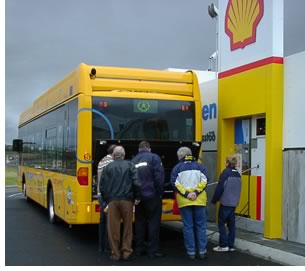 Hydrogen
is considered to be as safe as other commonly used fuels. An explosion
cannot occur in a tank or any contained location that contains only hydrogen;
an oxidizer must be present. There is little likelihood that hydrogen
will explode in open air, due to its tendency to rise quickly. Steve
Hoffman, an official at Air Products and Chemicals Inc., which is working
with Shell Hydrogen to open the Iceland hydrogen refueling station, summed
up the sentiment of the speakers. “Hydrogen is not
more or less safe than other fuels,” Hoffman said. “It's just
different.”
Hydrogen
is considered to be as safe as other commonly used fuels. An explosion
cannot occur in a tank or any contained location that contains only hydrogen;
an oxidizer must be present. There is little likelihood that hydrogen
will explode in open air, due to its tendency to rise quickly. Steve
Hoffman, an official at Air Products and Chemicals Inc., which is working
with Shell Hydrogen to open the Iceland hydrogen refueling station, summed
up the sentiment of the speakers. “Hydrogen is not
more or less safe than other fuels,” Hoffman said. “It's just
different.”
Green aluminum
Iceland knows how to capitalize on its water and geothermal resources.
In 2003, Professor Lee led Carnegie Mellon’s partnership with
Alcoa in designing a new low-emission, $2 billion hydro-powered aluminum
smelter on the eastern coast of Iceland. The government of Iceland
was interested in the smelter project because its eastern coast has
seen a decline in traditional industries such as fishing and agriculture,
causing an exodus to the west coast. The Alcoa project is aimed to
create many job opportunities plus be an incentive for other companies
to develop on its east coast. Another great expectation, however, is
that Iceland’s aluminum export revenues will double when the
smelter becomes fully operational. Site clearing and construction began
in 2004. It is supported by the Icelandic people, especially since
it is environmentally friendly.
 “We wanted to make a smelter that was sustainable,” says
Lee. “We had to ask ourselves about how to holistically integrate
the smelter into the community. Alcoa had already contracted with (Montreal-based)
Bechtel Mining and Metallurgy to be the engineer, do the procurement,
and be the construction manager of the entire project. They needed to
meet the Icelandic building codes, so they hired a local architect to
provide native services and have the project go through the building
permit process. Our teams wrote the environmental and urban design qualifications
with a great sensitivity to the site modifications and strategies to
capture the existing draining channels at the site as part of the new
architectural landscape that formed a series of wetlands, running channels
of water, and settlement ponds. We also designed the roof drainage.
“We wanted to make a smelter that was sustainable,” says
Lee. “We had to ask ourselves about how to holistically integrate
the smelter into the community. Alcoa had already contracted with (Montreal-based)
Bechtel Mining and Metallurgy to be the engineer, do the procurement,
and be the construction manager of the entire project. They needed to
meet the Icelandic building codes, so they hired a local architect to
provide native services and have the project go through the building
permit process. Our teams wrote the environmental and urban design qualifications
with a great sensitivity to the site modifications and strategies to
capture the existing draining channels at the site as part of the new
architectural landscape that formed a series of wetlands, running channels
of water, and settlement ponds. We also designed the roof drainage.
“But the challenge related to smelters is the release of hydrogen fluoride into the atmosphere. We developed a system where the raw aluminum powder works as a reactive agent in a solid scrubbing process that traps the hydrogen fluoride gas. That creates more raw aluminum, which just goes back into the smelter, in this continuous loop. They use natural ventilation forces, but any hydrogen fluoride that doesn’t get sucked up by the scrubber goes out through the stack and lands on the roof. Whenever it rains, the hydrogen fluoride is collected in the landscape and transported into the bio-remediation landscape onsite. The whole idea is to see that nothing would leave the site to pollute the area and neighboring communities.”
In addition to a spectacular site design that includes nature trails, Lee was able to integrate a series of terraces, walls made from local stone, and landscape mountains and habitats for animals. “It all makes the site look absolutely beautiful. We didn’t want that chain-link prison appearance.”
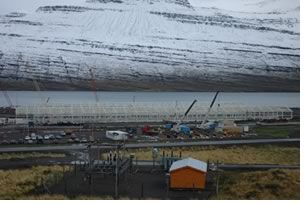 To Lee, it’s just the Icelandic way. “It’s just been
with them since they were born … there is all this hot water coming
out of the ground. They ask, ‘how can we use it’? So it’s
accepted. It’s not something they have to learn how to use because
they spent their whole lives consuming another source to provide that
energy that they need.”
To Lee, it’s just the Icelandic way. “It’s just been
with them since they were born … there is all this hot water coming
out of the ground. They ask, ‘how can we use it’? So it’s
accepted. It’s not something they have to learn how to use because
they spent their whole lives consuming another source to provide that
energy that they need.”
Hydrogen corridor here at home
On the homefront, Shell began building an “East Coast Corridor” in
2004, starting with a station in Washington, D.C., that showcases the
first hydrogen dispenser fully integrated at a regular retail gas station
in the U.S. It services hydrogen fuel cell vehicles made by General Motors.
This year, a station will be built in New York City. When another site
is built between the two cities, the foundation for the corridor will
be established. Says de Scheemaker, “The most important thing to
notice is that hydrogen is nothing special. People can walk up to the
pump, touch it, and see hydrogen refilling taking place.”
But he advises that public confidence about hydrogen here in the U.S. needs to be stepped up, saying that the response here varies from that of the Icelanders. “We’ve noticed a real difference between working in Iceland, where support and desire have really been built up over the years, and Washington D.C., where our project was originally greeted with both community and regulatory suspicion. It taught us a valuable lesson.”
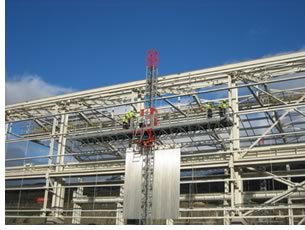 Icing on the hydrogen cake
Icing on the hydrogen cake
Last December, Iceland joined forces with the U.S. Civil Army Corps of
Engineers to test hydrogen power at the nation’s Kevflavik International
Airport. It is a significant location because the airport is both a
military and civilian airport, and the U.S. does have a military presence
stationed there. The objective is to see how hydrogen handles as a
backup to electricity for fueling emergency cargo vehicles. “It
is an ideal location for a fuel cell demonstration,” maintains
Skulason. “It will simulate support of critical or emergency
loads so that fuel cell power generation can be properly evaluated
as a backup power source.”
In 2015, the Icelandic government hopes to begin renewing its fishing fleet using fuel cells. By the year 2050, scientists and politicians are hopeful Iceland is the first country almost entirely free from fossil fuel. Iceland also expects to be a premier exporter of hydrogen fuel.
“Being independent of fossil fuel imports is a beautiful vision, which could be realized in Iceland during the next decades,” predicts Skulason. “Projects like ECTOS and others that INE is working on with international partners can and will provide valuable information for the next steps.”
Copyright 2006 The American Institute of Architects.
All rights reserved. Home Page ![]()
![]()
Did you
know . . .
• Unlike neighboring Greenland, Iceland is part of Europe, not part
of North America.
• Despite its name, only 10 percent of the island is composed of glaciers.
In fact, the chilliest thing about Iceland is its name! In January, the
average temperature in Reykjavik is higher than that in New York City.
• Iceland is the world's 18th largest island. Almost everyone speaks
fluent English.
• Icelanders aren’t given to formalities. The telephone directory
lists people by their first name.
• Iceland had only five Olympians at the Turin 2006 Winter Olympics,
all skiers.
Photos 1–6 courtesy of the Iceland New Energy Web site. ![]()
Photos 7–8 courtesy of Alcoa.
![]()